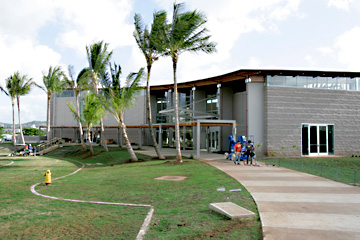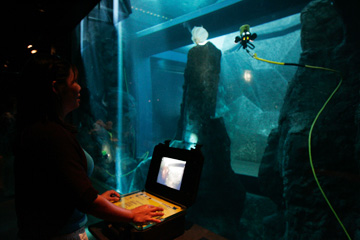 | ||||||||||||||||||||||||||
|
|
The museum worked closely with the state Department of Education on the theme, he said, explaining the purpose is to inspire and excite kids about Hawaii's environment and life sciences so "they can go back and do book-learning. "If you can engage kids in the nature of science, they will learn."
"I think buzz will be created about the science center. It's unique and fun," he said. "It's wonderful," said Lori Uradomo, who teaches third grade at Kapalama Elementary. "The whole exhibit is a lot of hands-on. With children or anyone, anything hands-on is really motivating, the best way to learn." Eight-year-old Wyatt Ma'a especially liked pressing "magma" and "gas" buttons to make the volcano erupt. "When we press it, the water goes up," he said. Compressed air fed into fountaining water creates steam and a geyser of bubbling red lava, explained Dave Kemble, senior exhibit project manager. "It's neat during the day but it's really cool at night," he said. Another favorite is a Hot Spot Demonstration Area focusing on the "hot spot" that created the Hawaiian Islands with lava rising up from the earth's mantle. A "lava plume" begins in the demonstration area and continues to the floor above to the top of the volcano. Specially trained staff melt chunks of lava in a large furnace and pour out molten rock to "oohs" and "ahs" of those watching. "It gets so hot, one mistake can be really, really dangerous," said Hiilani Shibata, protected with an aluminized Kevlar coat and leather and steel toe boots. "Yesterday, I had a piece of lava fall on me." "That was my best," said Shayna, delighted with the lava melting and different kinds of lava she saw on an overhead screen. Zarek liked a hot spot play in which the third-grade teachers wore costumes and acted the roles of kupuna who created the earth. Students also participated by reading lines, said Carrie Suzuki, one of the teacher-actors. "Part of the play was to show pictures. It was like a guessing game."
Zarek and Shayna learned from a display about Hawaii's natural history how plants and animals got to the islands by "hitching a ride." Wyatt was intrigued with exhibits showing how Hawaii "was born and how old it is" and how water "builds up" to make surf and waves. Brown said the science center has been in the works in different forms for more than 10 years. "Everything is new. We haven't picked cookie cutter exhibits off the shelf." It's the first time some of the technology has ever been used in a museum, he said. In a Conservation Hot Spots Laboratory, for example, species can be identified with a simulated DNA analyzer and highly magnified with an electron microscope. Brown expects other museums to draw on some of the exhibits and technology as they learn more about the science center. Hawaii's natural heritage is emphasized throughout the exhibits, starting with lava rock slabs, a wai (water) wall and manaki (wind) when visitors enter the pink building, across the campus from the 1889 Hawaii Hall. Hawaiian origins are stressed in a 160-foot-long darkened tunnel featuring innovative and whimsical student artworks illuminated by ultraviolet lamps. Walking through a coral reef and rainforest environment, visitors hear traditional Hawaiian chants and sounds of birds, water and wind. "Mostly it's kind of spooky," Brown said, strolling through the tunnel. "It takes you to a different place." A mezzanine bridge gives visitors a view of erupting molten lava at the top of the giant volcano and a chance to control the volcanic action. Rainbows can be created at another station by pushing a button to trigger a rainmaker in the ceiling but there is too much light to see it during the day, Kemble noted. "We haven't figured out how to modify it." A tree house in an ohia type of Hawaiian rainforest will have costumes so children 2 to 6 years old can pretend they're bugs, birds, plants and fishes. The kids' theater is part of a laboratory illustrating the native (good guys) versus invasive (bad guys) species in Hawaii. The children can act out environmental dramas as competing native and alien species, Kemble said. The science center also takes visitors to Hawaii's future island, Loihi, growing 3,000 feet below the sea's surface off the Big Island's southeastern coast. Using a throttle and joystick, they can pilot remotely operated vehicles (ROVS) around a diorama of Loihi's hydrothermal vents in a deep tank extending to the building's lower level. Brown hopes the pioneering science center will significantly boost the museum's membership and attendance. "There are a lot of local residents with families who have not been to the Bishop Museum that often," he said. But kids will want to go back to the interactive science exhibits and take their parents, he said.
The Grand OpeningA Grand Opening Festival for the Bishop Museum's new Science Adventure Center will be held from 9 a.m. to 8 p.m. Saturday with live entertainment, food and special programs.The entry fee is $3 per person for kamaaina and military and free for Bishop Museum members. Bank of Hawaii customers and employees can get up to four free admissions with a bank statement or bankcard. Others pay regular admission fees: $14.95 for adults; $11.95 for seniors 65 and older; $11.95 for youths four to 12 years old, and free for children under 4. The museum is located at 1525 Bernice St. and open daily from 9 a.m. to 5 p.m. For more information, call 847-3511 or see www.bishopmuseum.org.
Exploring the ExhibitZone 1 | Arrival & OrientationInteractive Islands Model: The Hawaiian Island Archipelago is depicted in a topographic model showing the islands -- stretching from Kure Atoll, the oldest, to the Big Island, the youngest -- are tips of a long mountain chain rising from the ocean floor.Wai (water) Wall: The importance of water in forming and sustaining life in the Hawaiian Islands is illustrated with a sheet of water gently falling down the face of this wall. Where In The World Interactive Globe: Pressing buttons raises the Ring of Fire volcanoes around the Pacific and illuminated, radiating rings that project distances showing Hawaii's geographical relationship with other land areas. Makani (wind) Wall: 45,000 mirrored metal discs hanging on hinged pins (one shown above right) flutter with a breeze to reflect the wind -- one of the natural forces that shaped Hawaii.
Zone 2 | Exploring Hawaiian OriginsOrigins tunnel: Colorful, imaginative artworks by students of five Oahu schools are illuminated by ultraviolet lamps in a dark 160-foot-long tunnel to present origins of Hawaii and Hawaiian creation myths. Traditional Hawaiian chants are interspersed with translations and sounds of water, wind and bird calls.
Zone 3 | Exploring the Volcanic Hot SpotHot Spot Demonstration Area: A foundry furnace that can heat up to 2,600 degrees is used for "fiery" demonstrations to illustrate the hot spot in the earth that created the Hawaiian Islands. Highlighting the demonstrations, museum staff members melt cinderblocks into molten lava and pour the molten rock out for visitors. Dramatic images of volcanic eruptions are shown on an overhead screen with a video microscope in the Hot Spot Theater. Rippling translucent panels in the ceiling suggest the molten core of an active volcano.
Zone 4 | Exploring Kilauea VolcanoPu'u O'o: Visitors can enter the volcano through a beaded "lava" curtain and explore hidden chambers. The main inner chamber features sculpted rockwork panels suggestive of Hawaiian lava flows and is projected to create an illusion of seeing the flows in three dimensions. Surrounding chambers within the volcanic cone feature volcanic specimens, footage of historic eruptions, and information on volcanic processes.Lava plume: Beginning in the Hot Spot Theatre and continuing up through the volcano to the lava lake on top, the molten magma breaks through to the surface and creates an eruption that can be seen from the second floor.
Zone 5 | Exploring Living IslandsTree House: Kids ages two to six can don costumes of bugs, birds, plants and fishes and play-act stories of competing native and alien species under a Hawaiian rainforest "canopy."Good Guys, Bad Guys Lab: Visitors using videoscopes with LCD monitors are "eye to eye" with endemic (good guys) and invasive (bad guys) species in a hands-on laboratory. Besides looking at damselflies, predatory caterpillars, centipedes, koa bugs and other live specimens, visitors can see living termite colonies in a shallow chamber with a glass top. Other examples of good and bad guy species in Hawaii are displayed in collection drawers.
Zone 6 | Exploring Ocean Hot SpotsOcean tank: Three types of waves -- normal surf, tsunamis and mega-tsunamis -- can be created with interactive stations in this tank with 30,000 gallons of water. A "deep tank" with floor-to-ceiling windows reveals a diorama of the undersea volcano Loihi 3,000 feet below the surface off the Big Island. Visitors can pilot remotely operated vehicles around the newest island with a throttle and joystick.� © Honolulu Star-Bulletin -- https://archives.starbulletin.com
| THIS ARTICLE
THIS EDITION
| ||||||||||||||||||||||||
 | ||||||||||||||||||||||||||











